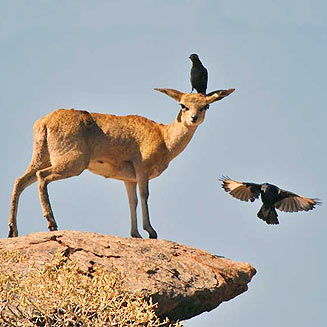|
Onychognathus nabouroup
(Pale-winged starling)
Bleekvlerkspreeu [Afrikaans]; Ndjundju (generic term for
starling) [Kwangali]; Vaalvleugelspreeuw [Dutch]; Rufipenne nabouroup [French];
Bergstar [German]; Estorninho-d'asa-pálida [Portuguese]
Life
> Eukaryotes >
Opisthokonta
> Metazoa (animals) >
Bilateria >
Deuterostomia > Chordata >
Craniata > Vertebrata (vertebrates) > Gnathostomata (jawed
vertebrates) > Teleostomi (teleost fish) > Osteichthyes (bony fish) > Class:
Sarcopterygii (lobe-finned
fish) > Stegocephalia (terrestrial
vertebrates) > Tetrapoda
(four-legged vertebrates) > Reptiliomorpha > Amniota >
Reptilia (reptiles) >
Romeriida > Diapsida > Archosauromorpha > Archosauria >
Dinosauria
(dinosaurs) > Saurischia > Theropoda (bipedal predatory dinosaurs) >
Coelurosauria > Maniraptora > Aves
(birds) > Order: Passeriformes
> Family: Sturnidae > Genus: Onychognathus
 |
 |
|
Pale-winged starling, Beaufort West, South Africa. [photo
Trevor Hardaker ©] |
Pale-winged starlings with klipspringer. [photo Callie de Wet ©] |
Distribution and habitat
Near-endemic to southern Africa, occurring from southern
Angola through Namibia to the Northern, Western and Eastern Cape, marginally
extending into the Free State. It generally prefers habitats with rock-strewn
hills and valleys, as it is dependant on them for nesting and roosting sites. It
generally avoids man-made areas, although it occasionally ventures into cities
in search of food.
|
 |
|
Distribution of Pale-winged starling in southern Africa,
based on statistical smoothing of the records from first SA Bird Atlas
Project (©
Animal Demography unit, University of
Cape Town; smoothing by Birgit Erni and Francesca Little). Colours range
from dark blue (most common) through to yellow (least common).
See here for the latest distribution
from the SABAP2. |
Predators and parasites
It has been recorded as prey of the
Falco peregrinus
(Peregrine falcon).
Brood parasites
It has been recorded as host of the
Great spotted cuckoo.
Food
It mainly eats insects, fruit, seeds, nectar and pollen,
foraging on the ground or gleaning food from vegetation; it also regularly hawks
prey from a perch. In addition it may remove ectoparasites from Klipspringers (Oreatragus
Oreatragus) and Mountain zebra (Equus zebra). The following food items have been recorded
in its diet:
- Insects
- Plants
- fruit
- Phoenix reclinata (Wild date palm)
- Ficus (figs)
- Diospyros lycoides (Bluebush)
- Cussonia spicata (Cabbage-tree)
- karees (Rhus)
- Heeria insignis (Rockwood)
- Lycium (honey-thorns)
- seeds
- Boscia albitrunca (Shepherds-tree)
- Cotoneaster (Cotoneaster)
- Crotalaria steudneri (Rattle-pod)
- Oleo europaea (Wild olive)
- Rhus lancea (Karee)
- Ziziphus mucronata (Buffalo-thorn)
- nectar and pollen of Aloe
Breeding
- Monogamous and semi-colonial, meaning that a number of breeding pairs may
build their nests in close proximity to each other on a cliff.
- The nest is a cup built of sticks and dry grass, typically wedged in a
crevice cleft in a rock, or rarely in building.
- Egg-laying season is from October-April.
- It lays 2-5 eggs, which are incubated solely by the female for about 20
days.
- The chicks are fed by both parents, leaving the nest after about 25
days.
Threats
Not threatened.
References
-
Hockey PAR, Dean WRJ and Ryan PG 2005. Roberts
- Birds of southern Africa, VIIth ed. The Trustees of the John Voelcker
Bird Book Fund, Cape Town.
|
